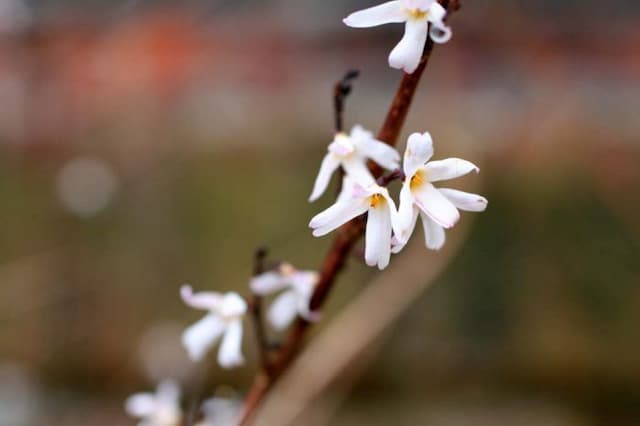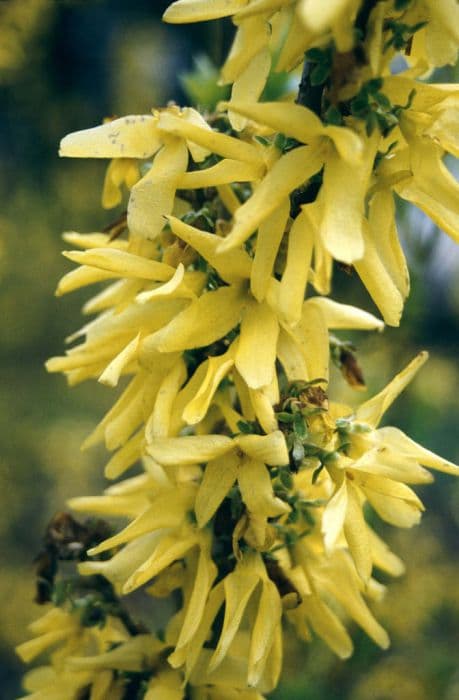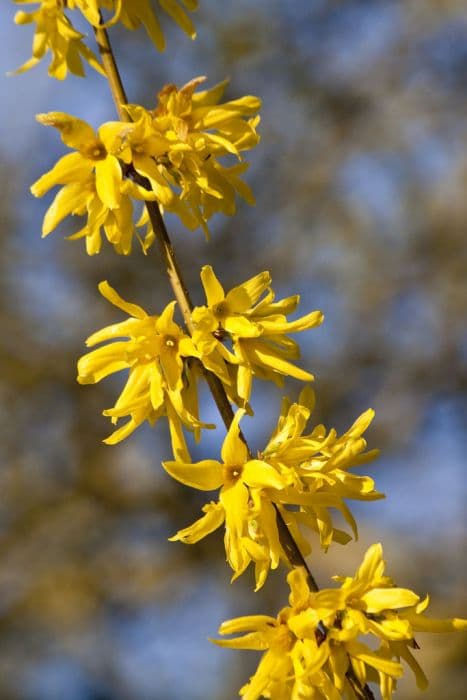Weeping Forsythia Forsythia suspensa 'Nymans'

ABOUT
The shrub known as weeping forsythia is characterized by its graceful, arching branches that offer a dramatic flair to landscapes. Its distinct appearance is marked by an abundance of bright yellow flowers that cover the branches early in the spring, often before the leaves appear. These bell-shaped flowers are a herald of the new season, standing out vividly against the bare branches. As spring progresses, the flowers give way to fresh, green leaves that create a dense, lush foliage. The leaves are slightly serrated on the edges and may have a pointed tip, offering a texture that is both soft and inviting. In the fall, the green leaves may turn to a golden yellow, adding another layer of visual interest and color to the garden. The berries that sometimes follow the flowers are inconspicuous and not a prominent feature of this plant. Overall, the weeping forsythia is known for its vibrant flowers, weeping habit, and changing foliage, making it a valued plant for seasonal interest and landscape beauty.
About this plant
 Names
NamesFamily
Oleaceae
Synonyms
Weeping Forsythia, Golden Bells, Lian Qiao
Common names
Forsythia suspensa 'Nymans'.
 Toxicity
ToxicityTo humans
Forsythia, including the variety Forsythia suspensa 'Nymans', is not commonly known for being toxic to humans. There are no well-documented cases or significant concerns regarding poisoning from this plant when touched or ingested. Therefore, no specific symptoms of poisoning are associated with forsythia for humans. However, as with any plant, individual allergies or sensitivities can occur, and it is generally recommended to avoid ingesting plants that are not specifically intended for consumption.
To pets
Forsythia is also not generally considered toxic to pets. It is not listed among plants that are known to cause serious harm if pets were to ingest it. Thus, there are no specific symptoms of poisoning commonly associated with the ingestion of forsythia by pets. However, consuming plant material can sometimes lead to mild gastrointestinal upset in animals, so it is always best to keep an eye on your pet and prevent them from eating ornamental plants.
 Characteristics
CharacteristicsLife cycle
Perennials
Foliage type
Deciduous
Color of leaves
Green
Flower color
Yellow
Height
8-10 feet (2.4-3 meters)
Spread
10-12 feet (3-3.7 meters)
Plant type
Shrub
Hardiness zones
5
Native area
China
Benefits
 General Benefits
General Benefits- Ornamental Value: Forsythia suspensa, commonly known as weeping forsythia, boasts vibrant yellow flowers that add striking color to landscapes in early spring.
- Early Blooming: One of the first plants to bloom in spring, it provides visual interest after winter when most other plants have yet to flower.
- Wildlife Attraction: The flowers provide an early source of nectar for bees and other pollinators emerging in the spring.
- Erosion Control: With its extensive root system, weeping forsythia can help stabilize soil and prevent erosion on slopes or banks.
- Easy Propagation: It can be easily propagated through cuttings, making it a cost-effective option for gardeners looking to expand their plantings.
- Low Maintenance: Weeping forsythia is known for its adaptability and can thrive with minimal care, making it suitable for gardeners of all skill levels.
- Screening: Dense branching habit makes it an excellent plant for creating privacy screens or hedges in the garden.
 Medical Properties
Medical Properties- Anti-inflammatory: Forsythia suspensa has been known to possess anti-inflammatory properties, which can help reduce inflammation in the body.
- Antiviral: The fruit of the plant is believed to have antiviral effects, especially in the context of certain viral infections.
- Antibacterial: It also has been used for its antibacterial properties, which can help fight bacterial infections.
- Antipyretic: Forsythia suspensa has traditionally been used to reduce fever.
- Antioxidant: The plant contains compounds that have antioxidant effects, which can help protect cells from oxidative damage.
- Hepatoprotective: There is some evidence to suggest that Forsythia suspensa may offer some protection to the liver.
 Air-purifying Qualities
Air-purifying QualitiesThis plant is not specifically known for air purifying qualities.
 Other Uses
Other Uses- Forsythia branches can be forced to bloom indoors during winter by cutting them and placing them in water, offering a flash of color and a hint of spring during the colder months.
- The bark of the forsythia plant is sometimes used in the craft industry for creating rustic wreaths and other decorative items.
- The bright yellow flowers can be used as a natural dye for fabrics and yarns, providing a soft yellow to greenish-yellow hue.
- In bonsai, forsythia is valued for its ability to be trained into miniature tree forms, showcasing its vibrant blossoms in small scale.
- Gardeners sometimes use forsythia hedges for maze or labyrinth designs in larger gardens due to their dense and easily shapeable foliage.
- The strong branches of forsythia are used to create natural support stakes for other plants in the garden.
- Forsythias, when dried, provide material for botanical illustrations and can be used in herbarium collections for educational purposes.
- Due to its fast growth and dense foliage, forsythia is occasionally used in theater productions and sets as a quick and effective background shrubbery.
- Forsythia can be used in flower arranging classes to teach about spring design trends and color palettes, due to its distinctive early blooms.
- Its flowers can be used as edible decorations for culinary dishes, particularly in gourmet and high-end food presentation.
Interesting Facts
 Feng Shui
Feng ShuiThe forsythia is not used in Feng Shui practice.
 Zodiac Sign Compitability
Zodiac Sign CompitabilityThe forsythia is not used in astrology practice.
 Plant Symbolism
Plant Symbolism- Anticipation: Forsythia, often one of the first plants to bloom as winter ends, is a symbol of anticipation and the coming of spring.
- Renewal: The bright yellow flowers represent renewal and new beginnings, as they are harbingers of the new growth that spring brings.
- Joy: The vibrant color of the forsythia is associated with joy and happiness, reflecting the uplifted mood that often accompanies the first signs of warmer weather.
- Cheerfulness: As a symbol of cheerfulness, forsythia's presence is believed to brighten spaces and bring a positive aura to gardens and landscapes.
 Water
WaterFor Weeping Forsythia, water deeply once a week, ensuring the soil is moist but not soggy. In dry conditions, increase watering to twice a week. Each watering should be around 1 to 1.5 gallons for an established plant, depending on soil type and weather conditions. Newly planted Weeping Forsythias require more frequent watering, about 1 gallon every three days, to help establish roots. Reduce watering in the winter when the plant is dormant.
 Light
LightWeeping Forsythia thrives in full sun to partial shade. The ideal spot would receive at least six hours of direct sunlight daily, but the plant can also tolerate some shade, especially in hotter regions. Avoid deep shade as it may hinder the plant's abundant flowering.
 Temperature
TemperatureWeeping Forsythia can survive winter temperatures as low as 5°F and summer temperatures up to 95°F. However, the ideal growing temperatures are between 60°F and 75°F. Forsythias are quite cold hardy and can even tolerate brief dips below their minimum temperature threshold.
 Pruning
PruningPrune Weeping Forsythia after blooming to maintain shape and encourage vigorous growth. Cut back about a quarter of the old canes to the ground each year to rejuvenate the shrub. The best time for pruning is immediately after the flowers fade in late spring or early summer.
 Cleaning
CleaningAs needed
 Soil
SoilWeeping Forsythia thrives in well-drained, fertile soil with a pH between 6.0 and 7.5. A mix of loam, peat, and sand ensures proper drainage and aeration. Amend the soil with organic matter to increase fertility.
 Repotting
RepottingWeeping Forsythia should be repotted every 3-5 years to refresh the soil and encourage growth. Spring is the best time to repot as the plant is entering a period of active growth.
 Humidity & Misting
Humidity & MistingWeeping Forsythia prefers moderate humidity levels but is quite adaptable and can tolerate the dry air commonly found indoors provided it's not too extreme.
 Suitable locations
Suitable locationsIndoor
Place in bright, indirect light and water regularly.
Outdoor
Plant in full sun to part shade and water deeply.
Hardiness zone
5-8 USDA
 Life cycle
Life cycleForsythia suspensa 'Nymans', commonly known as Weeping Forsythia, begins its life cycle when seeds germinate in spring after a period of chilling to break dormancy. The seedlings then develop into young shrubs with rapid growth, producing opposite leaves on arching branches. After one to three years, the plant reaches maturity and starts to flower in early spring before the leaves appear, showcasing yellow flowers that attract pollinators and aid in the next stage of reproduction. Following pollination, the plant produces fruits in the form of capsules that mature by late summer, releasing seeds for future generation. Throughout the growing season, it undergoes vegetative growth with regular cycles of leaf production and senescence, and in autumn, the leaves turn yellow before they fall. Finally, the plant enters winter dormancy, with stem and root systems surviving below the frost line, ready to begin the cycle anew with the return of warmer weather.
 Propogation
PropogationPropogation time
Spring to early summer
Propogation: The most popular method of propagating Forsythia, commonly known as Golden Bell, is through softwood cuttings. This process typically takes place in late spring or early summer. To propagate, a healthy, non-flowering shoot is selected and a cutting of about 4 to 6 inches (10 to 15 centimeters) long is made. The lower leaves are removed, and the cut end can be dipped in rooting hormone before being inserted into a well-draining soil mix. The cutting should be kept moist and in indirect sunlight until roots develop, which can take a few weeks to a couple of months. Once rooted, the new plants can be transferred to their permanent locations.








